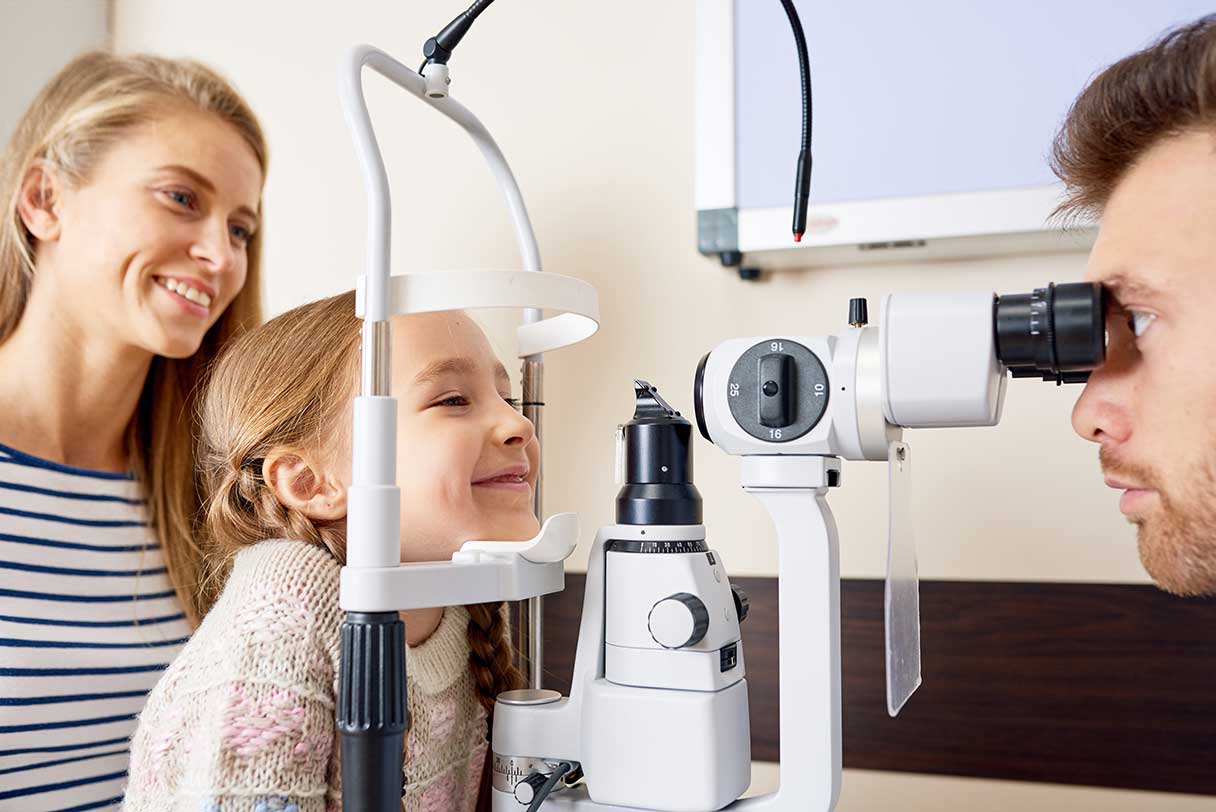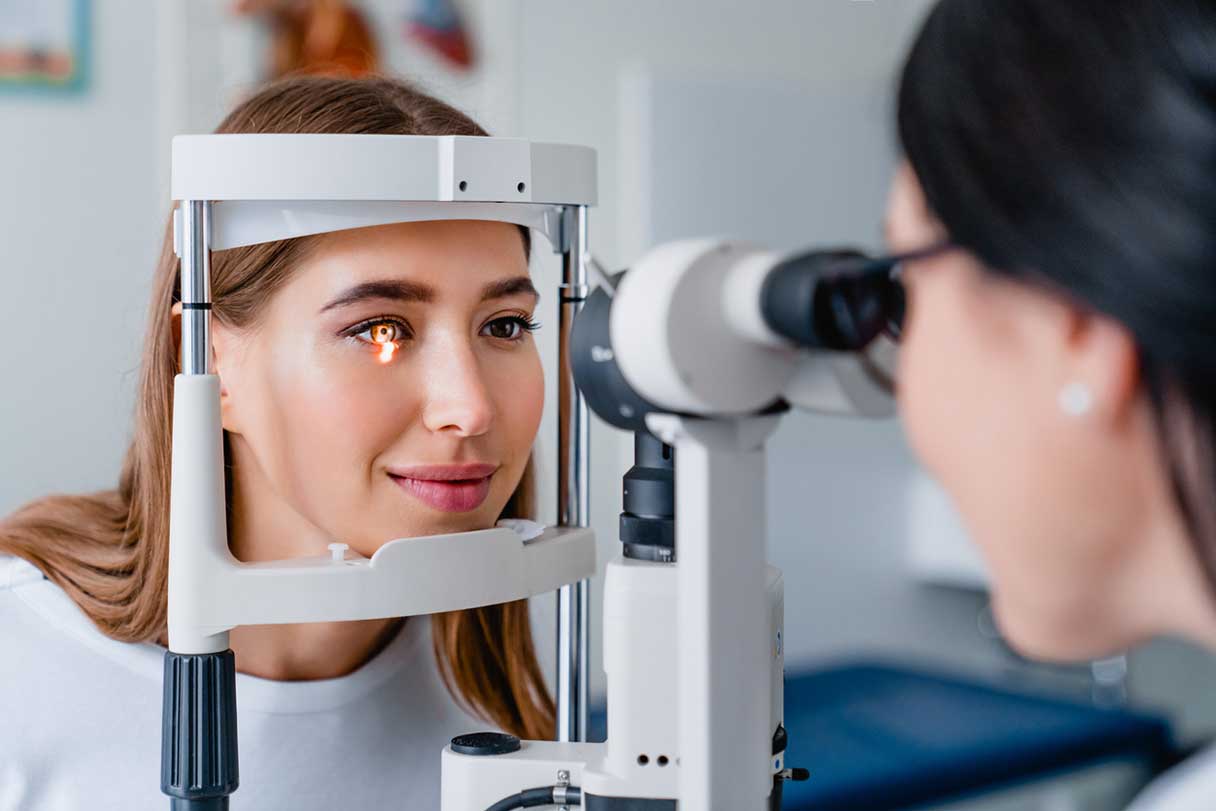The back-to-school season is full of excitement, from purchasing new supplies and clothes to the anticipation of the year ahead. But as parents check backpacks and pencils off their lists, one important item often gets overlooked: a comprehensive eye exam. Good vision is an important part of a child’s ability to read, learn and fully engage in school activities, like seeing the board clearly and participating in sports and hobbies.1
Include an eye exam in your back-to-school checklist to help set your child up for both academic success and overall well-being as they head into the new school year.
Vision Plays an Important Role in Learning
In the classroom, up to 80% of the material kids learn is presented visually.2 While clear vision is essential for reading, writing, seeing the whiteboard and using digital devices, vision problems are often undetected because kids might not realize what they’re seeing isn’t the norm.3 Other developmental visual skills that could be affected by poor vision include eye tracking, visual memory and visual thinking, peripheral vision, color and depth perception and visual integration.2
Catching Vision Problems Early
Kids’ eyesight can change quickly as they grow, and some vision issues may develop without obvious symptoms, especially if kids adapt to blurry vision because they don’t realize not everyone sees their surroundings the way they do.1
Routine eye exams are important for the early detection of new or worsening vision issues. Catching problems early allows your eye doctor to implement an appropriate treatment plan before these problems interfere with your child’s learning and social development.3
Common symptoms of vision problems in children
Parents should watch for symptoms that could be indicative of a vision problem. These behaviors can include:2
- Avoiding visually intense activities
- Difficulty concentrating
- Frequent eye rubbing
- Head tilting
- Headaches or tired eyes
- Poor reading comprehension
- Repeatedly losing their place on a page or skipping lines when reading
- Sitting very close to the board or TV, or holding a book very close to their face
- Squinting
Untreated vision problems can delay a student’s development of reading and writing skills, inhibit their classroom participation and affect their confidence and social interactions.3 Kids who can’t see well may seem withdrawn or inattentive and may be mistakenly misdiagnosed as having a behavioral or learning disability.1
What to Expect During a Pediatric Eye Exam
A pediatric eye exam is designed to check how well your child sees, as well as the overall health and function of their eyes. The eye doctor will typically begin by asking about your child’s medical and family eye health history, since some vision problems can be hereditary.4
During the exam, the eye doctor will check the clarity of vision (visual acuity) to see how well your child can see images or letters both near and far. The exam will check for eye alignment and movement to ensure both eyes are working together, as well as depth perception to evaluate how well your child judges distances. Using these tests, your eye doctor can diagnose common problems like strabismus (crossed eyes), amblyopia (lazy eye), myopia (nearsightedness) and hyperopia (farsightedness) that can affect learning and development if left untreated.4
They’ll also examine the structures inside the eyes — retina, optic nerve, cornea and iris — using special lights and lenses to search for signs of disease or developmental issues. Other tests may include checking color blindness, focusing ability, eye tracking and peripheral vision.4
Pediatric eye exams are appropriately adapted for children’s ages and abilities, sometimes using pictures instead of standard letter charts.4 Games may also be used to keep the experience comfortable and engaging for younger patients.2
If your eye doctor discovers a vision problem, they’ll recommend an appropriate treatment plan for correction that may include glasses, contact lenses or other eye therapies.4
Eye Exams vs. School Vision Screenings
A school vision screening, while helpful for checking basic distance vision, is not a substitute for a full eye exam. Vision screenings are useful in assessing obvious eye problems such as nearsightedness, farsightedness or astigmatism, but they don’t assess other important aspects like eye alignment, eye teaming (eyes working together), depth perception, focusing ability or overall eye health.1
A comprehensive eye exam evaluates each aspect of your child’s visual system and the health of internal ocular structures and can detect subtle issues that may interfere with reading, learning, hobbies and sports, even when a child passes a vision screening at school.4
How Often to Get Your Child’s Eyes Examined
The American Optometric Association recommends that children have their first eye exam by 6 months of age to ensure everything is developing normally. The next exam should occur around age 3, and again before starting school at around age 5. After that, unless advised otherwise, kids should see an eye doctor every two years to evaluate their vision as they grow.1
Tips to prepare
Prepare young children for the exam by explaining that the eye doctor will look at their eyes with special lights and show them pictures or letters. Reassure them that the exam is painless, and keep the conversation positive to ease anxiety or nervousness.5
After the exam, you can ask your child’s eye doctor:
- Are my child’s eyes working together?6
- Could vision issues be affecting their learning or behavior?
- Do they have any signs of conditions like nearsightedness, farsightedness or astigmatism?
- How often should we schedule follow-up exams?
- Is my child’s vision appropriate for their age?
- Is there a refractive error that glasses or contacts would help?6
- What testing procedures were used?6
Encouraging Everyday Eye Health
Support your child’s eye health and development with good daily habits.
Encourage your child to spend plenty of time outdoors, which allows kids to look at distant objects and recover from eye fatigue. Remind kids to follow the 20-20-20 rule when it comes to screen time: Every 20 minutes, look at something 20 feet away for at least 20 seconds to reduce eye strain from digital devices.3
Around 90% of eye injuries can be prevented with protective eyewear. Make sure your child wears the right eye gear during sports and activities where eye injuries could occur, such as baseball, racquet sports or woodworking projects. Additionally, protect their eyes from sun-damaging rays with sunglasses that have 100% UV protection.7
Nourish their eyes from the inside out with a diet rich in vitamins A, C and E, plus nutrients like lutein, zeaxanthin and omega-3 fatty acids, which support healthy vision and protect eye tissues. Leafy greens, carrots, citrus fruits, nuts and fish are good choices.8
Sleep allows our bodies, including our eyes, to rest and repair from the stressors of the day. Make sure your child gets enough quality sleep each night to support healthy vision in the morning.7
Your Final Back-to-School Eye Health Checklist
Keep an eye on your child’s vision with these tips:
- Write down questions to ask your eye doctor.
- Schedule a comprehensive eye exam before school starts or early in the school year.
- Be prepared with your child’s medical history and family eye health history.
- Bring your child’s glasses or contacts, if they wear them, to the appointment.
- Follow your doctor’s advice on timing for future exams to monitor your child’s vision as they grow.
- Encourage your child to spend time outdoors daily.
- Ensure they’re getting plenty of quality sleep.
- Make sure your child wears protective eyewear during sports and other activities where eye injuries could occur.
- Protect their eyes from sun damage with 100% UV sunglasses.
- Provide a balanced diet rich in leafy greens, colorful fruits and vegetables, fish, and nuts.
- Remind kids to follow the 20-20-20 rule for screen breaks.
- Watch for signs of vision problems at home like squinting, sitting too close to screens or books, frequent headaches or eye rubbing, or losing their place while reading.
Financing Eye Exams With the CareCredit Credit Card
Regular eye exams are an important part of your eye health. Whether you're getting an eye exam or paying for eye surgery, the CareCredit credit card can help you pay for care where your insurance leaves off.* Use our Acceptance Locator to find a vision specialist near you that accepts CareCredit. Continue your wellness journey by downloading the CareCredit Mobile App to manage your account, find a provider on the go and easily access the Well U blog for more great articles, podcasts and videos.
In addition to vision care, you can also use your CareCredit credit card for dentistry, cosmetic, pet care, hearing, health systems, dermatology, pharmacy purchases, spa treatments and so much more within the CareCredit network. How will you invest in your health and wellness next?
Author Bio
Anne-Marie Kennedy is a freelance writer with more than 20 years of experience covering health and wellness, personal finance and real estate/investing.







